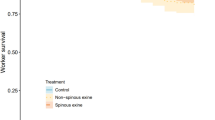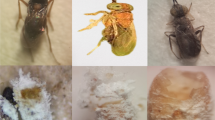Abstract
Allotropa subclavata Muesebeck (Hymenoptera: Platygasteridae) is one of the most effective natural enemies of the Japanese mealybug Planococcus kraunhiae (Kuwana) (Hemiptera: Pseudococcidae), a serious pest in Japanese orchards. We examined the developmental and reproductive traits including host deprivation effect on oviposition of A. subclavata to evaluate its potential as a biological control agent for P. kraunhiae. The developmental zero and effective accumulative temperature of A. subclavata females and males reared on second-instar nymphs, a suitable host stage for this parasitoid, were 12.3 °C and 514.3 degree days and 12.8 °C and 432.8 degree days, respectively. The longevity of A. subclavata maintained with honey was longer than that of those maintained with water or no feeding. The average numbers of mature eggs in ovaries of the 0- and 30-day-old A. subclavata females were 301.1 and 290.4, respectively, and were not significantly different. Offspring production of 30-day-old A. subclavata females was approximately 80% that of 0-day-old female parasitoids. On average, 50% of all eggs were laid within 24 h of the start of oviposition. The intrinsic rate of increase at 25 °C was 0.115, which is considered to be approximate to that of the host, P. kraunhiae.

Similar content being viewed by others
References
Beltrà A, Tena A, Soto A (2013a) Fortuitous biological control of the invasive mealybug Phenacoccus peruvianus in Southern Europe. Biocontrol 58:309–317
Beltrà A, Tena A, Soto A (2013b) Reproductive strategies and food sources used by Acerophagus n. sp. near coccois, a new successful parasitoid of the invasive mealybug Phenacoccus peruvianus. J Pest Sci 86:253–259
Beltrà A, Soto A, Tena A (2015) How a slow-ovipositing parasitoid can succeed as a biological control agent of the invasive mealybug Phenacoccus peruvianus: implications for future classical and conservation biological control programs. Biocontrol 60:473–484
Birch LC (1948) The intrinsic rate of natural increase of an insect population. J Anim Ecol 17:15–26
Boavida C, Neuenschwander P, Herren HR (1995) Experimental assessment of the impact of the introduced parasitoid Gyranusoidea tebygi Noyes on the mango mealybug Rastrococcus invadens Williams, by physical exclusion. Biol Control 5:99–103
Clancy DW (1944) Biology of Allotropa burrelli, a gregarious parasite of Pseudococcus comstocki. J Agric Res 69:159–167
Doutt RL (1964) Biological characteristics of entomophagous adults. In: DeBach P (ed) Biological control of insect pests and weeds. Chapmann & Hall, London, pp 145–167
Kawai S (1980) Scale insects of Japan in colors. Zenkoku-Noson-Kyouiku-Kyoukai, Tokyo, pp 105–106 (In Japanese)
Löhr B, Varela AM (1990) Exploration for natural enemies of the cassava mealybug, Phenacoccus manihoti (Homoptera Pseudococcidae), in South America for the biological control of this introduced pest in Africa. Bull Entomol Res 80:417–425
Mani M, Krishnamoorthy A (1989) Life cycle, host stage suitability and pesticide susceptibility of the grape mealybug parasitoid, Allotropa japonica sp. n. J Biol Control 3:7–9
Moore D (1988) Agent used for biological control of mealybugs (Pseudococcidae). Biol News Inf 9:209–225
Muniappan R, Meyerdirk DE, Sengebau FM, Berringer DD, Reddy GVP (2006) Classical biological control of the papaya mealybug, Paracoccus marginatus (Hemiptera: Pseudococcidae) in the Republic of Palau. Florida Entomol 89:212–217
R Core Team (2018) R: a language and environment for statistical computing. R Foundation for Statistical Computing, Vienna. Austria. http://www.R-project.org/
Sandanayaka WRM, Charles JG, Allan DJ (2009) Aspects of the reproductive biology of the Pseudaphycus maculipennis (Hym: Encyrtidae), a parasitoid of obscure mealybug, Pseudococcus viburni (Hem; Pseudococcidae). Biol Control 48:30–35
Sawamura N, Narai Y (2008) Effect of temperature on development and reproductive potential of two mealybug species Planococcus kraunhiae (Kuwana) and Pseudococcus comstocki (Kuwana) (Homoptera: Pseudococcidae). Jpn J Appl Entomol Zool 52:113–121 (In Japanese with english summary)
Spodek M, Ben-Dov Y, Mondaca L, Protasov A, Erel E, Mendel Z (2018) The cotton mealybug, Phenacoccus solenopsis Tinsley (Hemiptera: Pseudococcidae) in Israel: pest status, host plants, and natural enemies. Phytoparasitica 46:45–55
Tanaka M, Kobayashi M (1968) Oviposition and emergence of Allotropa sp. (Hymenoptera, Platygasteridae), a parasite of persimmon and citrus pest, Planococcus kraunhiae Kuwana (Hemiptera, Pseudococcidae). Proc Assoc Plant Prot Kyushu 14:58–61 (In Japanese with english summary)
Tanaka M, Kobayashi M (1971) Liberation of Allotropa subclavata (Hymenoptera, Platygasteridae) at the second generation of Planococcus kraunhiae (Hemiptera, Pseudococcidae) in a persimmon grove. Proc Assoc Plant Prot Kyushu 17:74–77 (In Japanese with english summary)
Teshiba M, Tsutsumi T (2004) The natural enemy complex of Planococcus kraunhiae injuring Japanese persimmons. Bull Fukuoka Agric Res Center 23:68–72 (In Japanese with english summary)
Teshiba M, Kawano S, Takagi M (2015) Host stage preference of Allotropa subclavata Muesebeck (Hymenoptera: Platygasteridae), a parasitoid of Planococcus kraunhiae Kuwana (Homoptera: Pseudococcidae). Kyushu Plant Prot Res 61:68–72 (In Japanese with english summary)
Acknowledgements
We thank Dr. Takafumi Tsutsumi for his useful comments on the experiments. We thank Dr. Takatoshi Ueno, Dr. Midori Tsuda, and all the staff members of the Laboratory of Insect Natural Enemies, Kyushu University. We are grateful to the anonymous reviewers for their valuable comments.
Author information
Authors and Affiliations
Corresponding author
Additional information
Publisher's Note
Springer Nature remains neutral with regard to jurisdictional claims in published maps and institutional affiliations.
Rights and permissions
About this article
Cite this article
Teshiba, M., Kawano, S., Tokuda, M. et al. Development and reproduction of the parasitic wasp Allotropa subclavata (Hymenoptera: Platygastridae) on the Japanese mealybug Planococcus kraunhiae (Hemiptera: Pseudococcidae). Appl Entomol Zool 54, 313–318 (2019). https://doi.org/10.1007/s13355-019-00628-y
Received:
Accepted:
Published:
Issue Date:
DOI: https://doi.org/10.1007/s13355-019-00628-y




